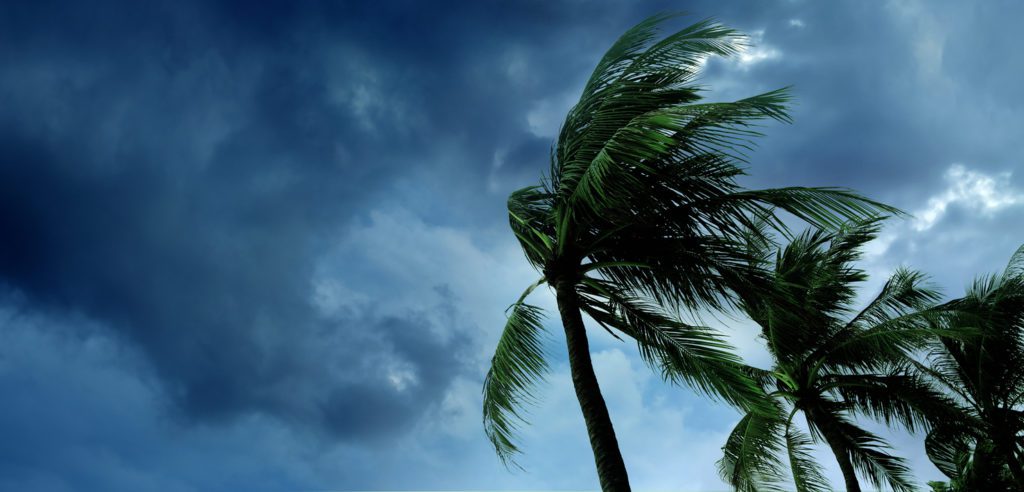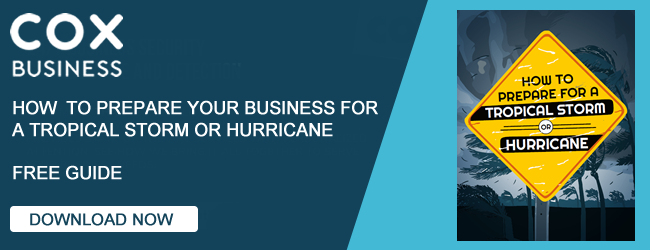How to Prepare Your Business for a Tropical Storm or Hurricane
Knowing how to prepare your business for a tropical storm or hurricane is essential in many parts of the country. It’s important to take time to continually evaluate your level of preparedness and make the necessary changes.
According to the Federal Emergency Management Agency (FEMA), almost 40-60 percent of small businesses shuttered by a disaster never reopen their doors.
The good news is there’s a lot you can do to prepare for a tropical storm or hurricane, in contrast to more sudden natural disasters. If you take the time well before any storm hits to consider the worst-case scenario and how it can impact your business, you’ll know what to do before, during, and after to make sure that you’re in the best possible position to keep everything running smoothly and safely. In this guide, we’ll look at each phase to identify the key steps you need to take to be ready for anything.
1. Before the Storm
The most critical time for your business to prepare for a tropical storm or hurricane is right now before it’s an imminent threat. It’s vital to think through all the implications of how a bad storm (and the flooding after) could impact your business and make decisions on what you’ll do about it.
You don’t want to be frantically weighing the pros and cons of something in the moment because you’ll surely overlook something important. Instead, make the hard decisions in advance, so when you’re in the moment, you can trust your earlier decision-making and just follow the plan.
2. Make an Emergency Planning Team
Before a storm hits, you need to make a plan, which means understanding everything about your business that could be impacted. That’s probably too much for one person, as no single employee can track the day-to-day tasks of every member of your team.
If you’re going to make a comprehensive emergency plan, however, you’ll need to make a cross-sectional Emergency Planning Team where each part of your business is represented. You’ll also want to mix things up in terms of the level of seniority and type of employees you include, as someone who works shifts is going to have a very different perspective than a full-time nine-to-fiver, for example.
3. Identify the Mission-Critical Aspects of Your Business
The first job of your emergency planning team is to identify the mission-critical (or business-critical) aspects of your business. The simplest version of this is a list of everything that needs to happen in order for your organization to do its job. It’s going to be hard to get a complete picture without ending up with a ridiculous amount of material to sift through, so keep it focused on what tasks need to be completed to fulfill each person’s key responsibilities.
Once you have a list, separate items based on how frequently they need to happen. Is it a daily, weekly, monthly, or quarterly task, or something else? The question you need to answer is this: How long could your business go without this thing getting done before it would cause a major problem?
Identifying what is mission-critical to your business and understanding how it all fits together gives you a framework for understanding your priorities during the recovery phase. You gain an understanding of which services and functionality need to be restored to which department, and at what level of urgency. This is a good list to have no matter what happens, but in an emergency, it is invaluable.
4. Know Your Evacuation Path
Often, states create evacuation zones based on each area’s risk. Most states have an online tool you can use to figure out your zone based on your address. (For example, here are the “Know Your Zone” pages for Florida and Virginia.)
Coastal Georgia has evacuation maps planned out, and you can look at the tiered evacuation plan for Hurricane Irma to have some sense of what might happen in a similar storm. The higher priority your zone is the higher your risk of being impacted by a hurricane or tropical storm.
An essential step in storm and hurricane preparedness is knowing the evacuation route from your business location.
5. Taking Physical Security Into Account
Beyond a flood or evacuation map, you need to understand the physical preparations your business must take to be ready for a hurricane or tropical storm. Are there particular parts of your building that are susceptible to flooding? Do you have a lot of windows that need to be boarded up? Is there anything that needs to be brought inside, locked down, or secured?
Most importantly, if someone is caught at your physical location, do you know the safest place in your business for them to take shelter? Do you have an emergency kit readily available? Storm and hurricane preparedness is more than just planning, it’s critical that execute each part of the plan, and take the physical steps necessary to safeguard your business and protect your employees.
The biggest threats to personal safety during a hurricane are high winds (which can break windows and skylights), flooding (and therefore electricity), and lightning. Make sure that anyone who may be at your location at odd hours knows the safest place to be, and understand your timeline so that you’re not asking someone to be there close to an evacuation deadline. If there’s not a great place to take refuge, know that you need to take extra care to ensure you’re never placing your team in harm’s way.
These considerations are also important when preparing your building for the coming storm. If your location is particularly at risk for flooding, make sure someone is turning off the breakers and moving any key equipment out of the water’s reach. If your servers are in the basement, you probably need to figure out how to get them somewhere else.
You can also use this as an opportunity to take stock of how prepared you are to get everything ready at a moment’s notice. Do you have the materials you need on hand to board up your windows, and does everyone know where they are?
6. Review Your Insurance
The 2017 hurricane season was the most expensive ever, with over $202.6 billion in damages. If you’ve determined that your business is at risk, you need to conduct a comprehensive review of your current insurance policy and make sure that you’re covered when you need to be.
Insurance can get very technical when it comes to figuring out what’s covered and what’s not. Take the opportunity now to dive into the nitty-gritty, so you’re not caught by surprise when something isn’t covered.
The most important thing to pay attention to in an insurance policy is your deductible so that you know how much money you’re responsible for before you can start rebuilding. You’ll also want to review your exclusions to make sure that you’re covered for flooding, windstorm damage, expenses related to setting up a temporary location, and any personal property you might have on the premises.
If you find that your coverage is inadequate to get your business back up and running after the storm, either look for a more comprehensive policy or make a plan for how you’ll save enough money to cover the cost as quickly as possible. At its heart, insurance is always a form of gambling: “I’m willing to pay $X so I don’t have to pay $Y if scenario Z happens.” Make sure that you’re making a smart bet, but don’t be penny-wise only to find out you’ve been pound-foolish.
7. Consider Technology Options to Improve Your Resilience
When it comes to maintaining business-critical functions in a disaster, the cloud offers a lot of options that can help you keep things running no matter what happens. A business telephone service with a hosted voice can effortlessly reroute calls to make sure that, even in the worst-case scenario, someone will pick up the phone. Managed IT services can help you ensure that no matter what happens to your physical location, your data is protected and recoverable.
Videoconferencing and project management platforms can help you keep your team productive regardless of the status of your physical location. Take the time now to look at your needs, and consider potential technology solutions that work for you.
8. Make Your Plan
After your team has considered everything that goes into preparing for a tropical storm or hurricane, it’s time to make a plan. That means taking what you’ve learned, committing it to writing, and breaking it down into actionable steps that each team member can execute when you get the news that a storm is on the way.
The important thing here is to write everything down and choose a clear way of communicating to everyone what needs to happen and when. Make sure that you incorporate contingencies into your plan, as you never know how what actually happens will differ from the scenario you’ve drawn up. Give people the freedom to make decisions that are best for the specific situation that arises, while also being clear about your overall goals.
Most importantly, be sure that, once you make you plan, you don’t stuff it in a drawer somewhere until a storm hits. Schedule regular updates to your hurricane and tropical storm plan to ensure you don’t have a bunch of broken hyperlinks and outdated resources when it comes time to execute it.
Finally, have a plan for how you will communicate your situation and progress to your customers. It’s important to set expectations clearly from the start and remember that any communication is better than no communication.
Figure out what each stage of your recovery means in terms of what customers can expect, and draft language that is honest about the challenges you’re facing and how you’re trying to meet their needs in the face of those challenges. Drafting everything now will save you the hassle of crafting the right messaging in the midst of getting the lights back on.
9. Practice, Practice, Practice
Drawing up a plan is well and good, but it doesn’t mean anything if your team doesn’t know how to execute it. Once you have a plan put down in writing, it’s time to give it a trial run.
There is a reason that fire safety preparedness places such a heavy emphasis on drills. Your team needs time to go through the motions of reading a phone tree and making sure everything is safe from a windstorm without the pressure of an actual natural disaster bearing down on them.
While it may take some time out of your day, it’s important to give your tropical storm and hurricane plan a walkthrough before you actually have to use it. Practicing will also help you identify where you’re missing a step or have been unclear.
The more times you drill your plan, the better. Humans are creatures of habit, so the more chances your team gets to practice, the more they’ll be able to react without overthinking and respond to what’s actually going on. As you’re running practice scenarios, make sure that the details change so that they’re engaging their critical thinking skills and considering the overall goal, not just executing the specifics of your plan documentation.
10.During the Storm
During the storm, the most important thing you can do is follow the advice of the relevant authorities and make sure you’re on top of any new developments. Getting a National Oceanic and Atmospheric Administration radio, or NOAA radio, also called a weather radio, can help you keep track of the latest developments. There are NOAA stations for each state that provide updates on current atmospheric conditions and any special warnings in effect for your area.
For hurricanes and tropical storms, it’s important to remember that there is an eye of the storm (an area of calm weather) in the middle. The seemingly safe conditions may tempt you to venture forth and check on your business, but don’t be fooled. It is extremely dangerous to go out during the calm weather because you don’t know when you’ll be hit by the rough conditions waiting on the other side of it. Make sure that you and your loved ones are safe, and worry about your business later.
Consider communicating your status and the status of your business (if you know it) to your customers. Be unambiguous about how you’re affected and when they can expect you to reopen.
If you’ve done your homework, you should have a solid plan in place for how to manage everything that comes up. At the same time, don’t let what you’ve drawn up blind you to what is actually happening. Keep in mind the goals you came up with during the research phase of your planning, and empower your team to make any adjustments needed based on the conditions on the ground.
11. After the Storm
After the storm has blown over, it’s time to assess the damages and figure out how to get your critical business functions back up and running as quickly as possible. Part of that will be figuring out clean-up and communicating with customers about what to expect.
12. Hire a Disaster Recovery Service
Hurricanes, tropical storms, and the flooding that comes with them can cause a lot more damage than meets the eye. Even if your business looks more or less completely intact, the best course of action is to hire a professional to come in and assess the damages. Electrical and utility damage can cause all sorts of problems that you might not anticipate and can lead to safety hazards or even more damage down the road.
For things like document recovery, a disaster recovery service can use specialized processes to make sure you get back as much as possible. It’s important to take action quickly, as humidity and high temperatures are great conditions for mold.
13. Repair Your Equipment and Recover Your Data
Depending on your industry, it may be important to get in touch with professionals about repairing any key equipment that needed to stay on-premises. Again, even if something looks unaffected, you won’t necessarily know what’s going on under the hood.
Your best bet is to contact a professional and let them decide what’s safe to use and when you can use it. For computer equipment, send hard drives to professional data recovery services to see what they can salvage.
14. Look Into Recovery Options and Reopen
As you clean up, make sure you’re looking into green options for your refuse. Many materials may be recyclable, and you’ll need to make sure you’re disposing of electronics and other sensitive materials safely. Remember that moisture is your enemy, and running your air conditioner or using a dehumidifier can help you dry everything out as quickly as possible.
The federal and state government may provide aid to small businesses, so do your homework and apply to any programs you qualify for. Your local small business association can probably assist with identifying programs and resources that may be of use.
What You Can Do Right Now
Careful storm and hurricane preparedness planning can go a long way towards helping you weather a crisis brought on by storm. Here’s what you can do right now to make sure that your business is ready for whatever nature throws your way.
- Prioritize your personal safety, and remember your business is never more important than your life.
- Make an emergency planning team to review all aspects of your business that may be threatened.
- Identify mission-critical operations, and make a priorities list.
- Conduct a threat assessment to understand your risk.
- Audit your insurance policy to make sure you’re covered.
- Look into tech solutions that can increase your resilience.
- Work with professionals to clean up the mess.
- Research resources to help you recover.




